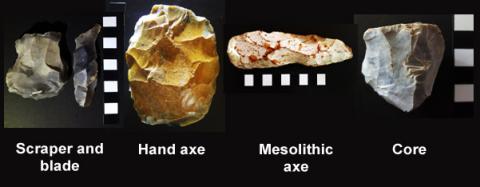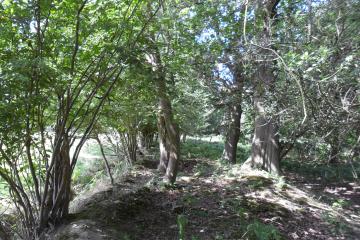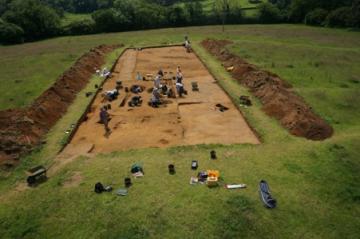Prehistoric
Mesolithic
The Mesolithic period c. 9300 - 4300 BC
The vast period of the ‘Stone Age’ is often broadly generalised in terms of the key developments which took place, though many concepts have since evolved over the years. The Meso- (‘Middle’) era is one which is most commonly characterised as the period of nomadic groups living off of what they could hunt or gather seasonally, during a period which shifted to covered woodland as a result of rising sea levels and climatic warming.
Palaeolithic
The Palaeolithic period c. 850,000 - 9000 BC
The vast timespan of the ‘Stone Age’ – over half a million years – is often difficult to conceptualise, not least because it is represented by a wide diversity of artefacts and complexity of themes. The Palaeolithic (or ‘Old Stone Age’) is the era which begins with the earliest humans and ends with the retreat of the glaciers in the last Ice Age. Although much of our evidence is in the form of the flint tools left behind in the archaeological record, other sites from around Britain can give some insight into other aspects of material culture, including art.
Ceramic Building Material Group

Part of the Artefacts and Archives Research Groups
New Lithics Group

Part of The Artefacts and Archives Research Groups
An analytic survey of Dry Hill Camp 2011-2013
Dry Hill Camp is a large enclosure of probable Iron Age date looking across the Eden/Medway Valley to the northern part of the Low Weald and North Downs. It is multi-vallate and lies just within Surrey, close to both Kent and Mid-Sussex. An excavation in 1932 recovered few finds and the site remained enigmatic. From 2011-2013 a level 3 tape and compass survey to check the condition of the earthworks was undertaken and a report is now available in the pdf attached below.
Excavations at Cocks Farm Abinger 2014
First of all, a big thank you to everyone who helped to make the latest season at Abinger such a success. It may seem odd to say that in view of our failure to finish the trench, but this was a result of finding that there was more surviving archaeology than anticipated. Much of this must be down to your hard work in tackling the difficulties of finding archaeological features in sand. As a result we have a much better understanding of the site and how to approach it in future.
2008-2009 Hascombe Hillfort Survey
An analytical survey of Hascombe Hillfort (TQ 005 386) was carried out by members of the Surrey Archaeological Society over the winter of 2008-09, and a magnetometry survey of part of the interior took place in the spring of 2009. A full report of these activities (of which this is a summary) has been lodged in the Surrey Archaeological Society library.
Setting:
Egyptian Art
Two creative time sessions learning about the ancient art of the Egyptians and mummies.
£8 per child plus £1 sibling discount. Spaces are limited to 15 per session so booking early is essential.
Contact: dbrooks@epsom-ewell.gov.uk
Weston Wood, Surrey: prehistoric pottery report 2019
A new report on the prehistoric pottery from rescue excavations carried out between 1961 and 1968, at Weston Wood, Surrey, ahead of sand extraction, has just been published online.
Charlwood Excavation 2019
In November 2019 the final season at this muddy site took place. The intention was only to complete excavating a few features which had been left unfinished in 2018 when the team had to leave the site due to the deeply unpleasant conditions caused by the ‘Beast from the East’. Fortunately November 2019 was rather kinder and in spite of some rainy days there were enough dry ones for the work to take place within few days. In November 2019 the final season at this muddy site took place.





